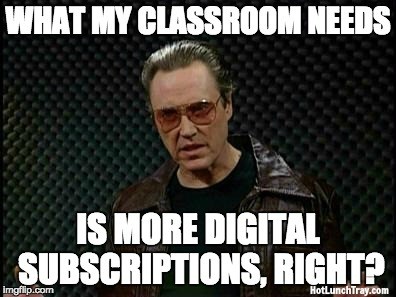
Classroom Essentials
You used to mean pencils, paper, and textbooks when you used the phrase “classroom essentials.” Now a days that phrase could apply to an array of digital subscriptions, content, or platforms, which could be purchased by you, your school, or your district/state to aid in your instruction.
What it takes to define something as essential is shifting. It used to be tangible supplies, but now it is also digital platforms, content, and apps around which we build our instruction. It used to be if you didn’t use all the glue this year you did not have to buy as much glue next school year, but that paradigm does not apply to digital subscriptions. Digital subscriptions are similar to Scholastic’s Weekly Reader subscriptions in that the content was there, whether you used it or not. But unlike student magazines building up in your mailbox, digital subscriptions are less obvious in their usage or lack of usage.
Ownership of Content
Districts are purchasing learning management systems and/or content management systems (LMS/CMS) for district distribution of content. It is within the reach of a district budget to do so and it can be a cost-effective purchase – even if it is a recurring yearly cost – they are more cost effective the more people use them. LMS and CMS can replicate content across the district. Content which teachers upload to these platforms can be replicated as “work products” for the district. Attempts to have teachers write digital content which would be completely owned by the district are time and resource intensive.
Reference Michael B. Horn’s iNACOL Leadership Webinar | Blended: Using Disruptive Innovation to Improve Schools. Page 38 helps visualize that the closer to one source the content is the higher the quality of the content over time. In general the fewer content sources, the higher the quality over time.
Districts also purchase specific content subscriptions for subjects or grade levels within the district. Sites such as Defined STEM, BrainPop, and LearnZillion provide content. The challenge of using this content in a LMS or CMS is two-fold: purchasing the correct licensing and incorporating this into the LMS/CMS (so the teacher does not have to do so). Individual schools might also add-on purchases and desire them to be represented in the district LMS/CMS. The terms of the licensing are dictated by the content companies typically and while concurrent licensing could be set to align to
Along with the proliferation of digital subscriptions to which schools and districts subscribe, teachers are purchasing digital products themselves. Teachers create and purchase items from Teachers Pay Teachers or TPT (referral link) because the unit of production and/or purchase is within the time/monetary budget of a classroom teacher. And teachers fold these purchases into their lessons as you expect.
So the delivery of lessons to each classroom can now be influenced by district, school, individual teacher purchases. That means that even before applying individual teacher purchases, classrooms at School A might have a different product to deliver to their students than School B. The idea for content being shared district-wide is complicated. Now if you add in the individual teacher purchases, even classroom within School A might be able to share content.
While teachers can often expect assistance in incorporating content into a LMS/CMS it is often more intricate to separate out content which belongs to one teacher or select schools. Teachers may insert one-time purchases into units, but those purchases may not cover more than one user or storage digitally. Subscriptions intertwined into pre-planned, future units are subject to the continuation of the purchase of those subscriptions. While taking media and transforming it into something new is a prerogative of K12 under Fair Use, adding content owned by a company into your LMS/CMS is not protected and is something someone must pay for – often yearly.
Gathering Your Essentials Together
The initial years of digital subscriptions were awkward. A teacher could expect multiple logins, different URLS, and the manual creation of student user accounts …. Ugh. When looking at vendors of digital subscriptions now: Single Sign On or Same Sign On (SSO), partnerships with multiple LMSs, and interoperability are part of discussions for larger, district-level purchases.
Some larger districts are asserting their purchasing power and it will benefit the rest of us … eventually. Large districts which already have LMS/CMS are demanding that the vendors from which they purchase their digital subscriptions conform to a standard which allows for some teacher conveniences. This standard is called Learning Tools Interoperability (LTI) and is promoted by IMS Global Learning Consortium and it is something you can look for when vetting or recommending to those purchasing content in your district. So no additional logins, no independent usernames for differing programs, and – aside from maybe launching in a new browser tab- all of your instruction in one “place.” Typically LTI makes integration easier from within a LMS/CMS. Within a LMS/CMS the vendor’s LTI content or digital subscription should be able to recognize the users and sign them into the content/subscriptions – sometimes even grade pass back to the LMS/CMS grade book can happen.
As your district or school moves to one or more platforms to deliver content and/or digital subscriptions, you need to be aware of the complications along with the solutions such content brings. Realizing increasing subscriptions and/or content does not equal more or better learning is increasingly important as money is a finite resource and we know that content soon becomes entrenched, essential to some classrooms. As you bring new digital subscriptions or content to the purchasers in your district be aware of the complexities they face and look for LTI-compliant products when possible.
Good luck out there – I hope your stockpile of glue lasts!





2021-11-22 at 5:45 am
This is really informative and interesting.